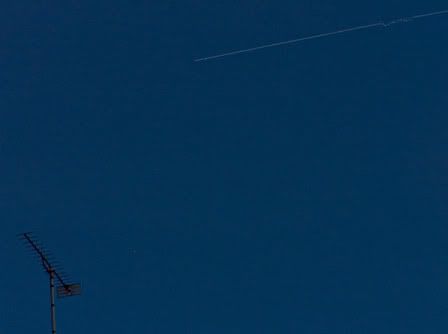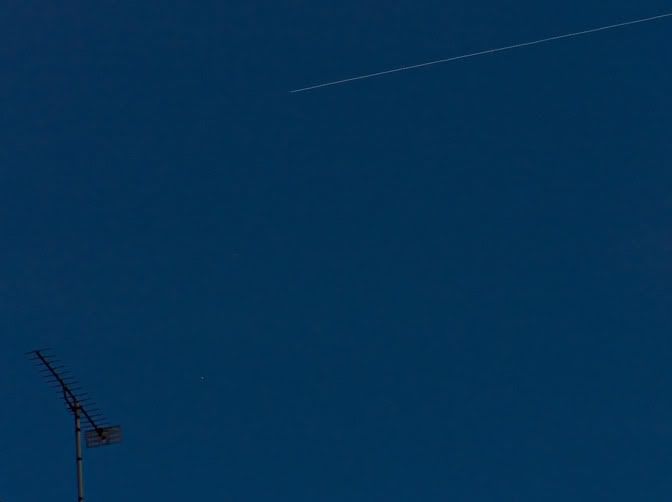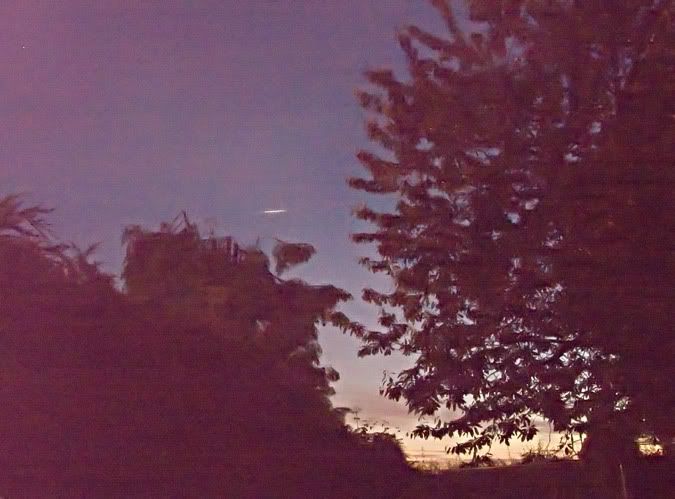Finally after what seems like weeks of cloudy nights, it's odd that it seems to be so overly long between gaps, the sky was clear last night. It didn't get dark, proper dark till really late though. I'd never noticed before how late the sky finally gets dark in the summer months. I guess the longest day is only just around the corner.
I checked on HA for pass details on the ISS and for Iridium Flares. A couple of reasonable if low passes to catch. So as time ticker on towards 2200, I got setup for the first go of the night, the ISS. I set up the SatCatcher and aligned on the Alt and Az bearings. I snapped a couple of test shots, as the sky was just so bright still, for taking 15 second exposures and ended up setting the aperture closed down. On cue, I could see the ISS skating across the sky, no up and over for the speedster tonight. I fired the shutter at the right time, then about 5 seconds into the shot, nudged the tripod, only a little, and I'd hoped I got away with it, but no. Blast it (that wasn't what really came out, but I can't use that on here).
The unedited disaster (I spose as disasters go this is pretty mild really ;o)):
Then I used some of the skills I've picked up over the past few months with PS to "adjust" the image to make the path correct:
At least I got a usable image out of it. Still over 40 minutes till the Flare and the sky was too bright to really see much as yet, so after aligning the SatCatcher, I popped in for a while leaving the setup ready for the flare. For some reason, when I came back to it, the camera wouldn't awaken from it's sleep. Never done that before. Anyway, I ended up having to power off and on the camera again. This of course reset a couple of things. So after setting the focus point and checking the format, I was ready to go or so I thought. I didn't check/reset the zoom, so instead of zooming about 60% as I'd planned the camera was on it's widest setting. I also forget to reset the aperture to it's most open and the camera tried to compensate but it made the image really very noisy. After some swearing and editing in PS I ended up with this
I caught it but not as I'd wanted to. Oh Well.
Than I collected the Bins, had a look on Stellarium for the Bin objects on the list that I'd found for June, made some non detailed instructions on how to find them and headed out again. First off I tried to locate Mel 111 as a reference point. Hmm, having some trouble here. Whilst hunting around, I noticed a little dot moving across the sky, it was in the west and heading from South to North, checking HA this was Cosmos 1703.
I gave up on Mel111 for a while, let's be honest, my eyes had hardly adapted properly as yet, so I spent the time as productively as possible trying to locate constellations. I could only positvely identify 5 that I haven't seen before, Virgo, Crater, Corvus, Lyra and Cygnus. I know there are others, but due to my viewing position, and no sign of the eastern sky, the house is in the way, I couldn't see them at all. This all took a while as I was struggling with my bearings as everything has moved on so far.
Afterwards I went back to the Mel111 hunt. Whilst I was looking, there's another one. This dot was really rather dim, to the point I could only see it in the bins. So it was pure luck that I even caught this one at all. A check on HA showed it to be SeaSat 1. Yet moments later, and there's another one, this one was Terra. Then my eyes now adjusted, I started finding things. Firstly M5, it's hard to see Globular clusters in bins, but I'm pretty sure that's what I found. By comparison to the stars nearby this was a faint blob in about the correct location. Then I found Mel111, ah that's better. I think Mel111 is my favourite cluster at this time of the year, although there's a few more waiting in the wings, hiding behind the house, that I haven't seen as yet. Then onto M3, using Mel111 and the corner star of Coma Berinices to locate it. Then two more Satellites passed across the sky. I haven't been able to find these, both at approx 2310, one in the North heading North, the other in the West heading West to East.
Then, I guess I got lost in the starfields whilst looking for my next target. I forgot about looking for the objects that I'd noted (although it must be said, that a number of them were too far to the east and therefore hiding behind the house) and had one of those Wow!!! moments as I realised again exactly how many dim pinpoints of light are hiding away up there just out of reach of sight.
After about 30 minutes of swinging the bins around just looking, I came in as I was getting cold. I'd only popped out in a fleece over the top of my clothes (before anyone makes any funny comments!! yes you know who you are...), not thinking about putting on the full winter gear as it's summer right ?
The gremlins were out in force tonight, thankfully nothing except my intentions was broken and I was able to fix one of the problems caused with some judicious use of the clone tool in PS.
There was, however, one final surprise to come. I was awoken at about 0330 this morning by work, and once I'd finished on the call, as the sky was still clear, I popped out to see what was about. There in the South East, was a surprisingly bright spot. I fired up the computer to confirm my suspicions, and I was correct, it was the king of the planets. I quick look in bins proved this to be the case, although Jupiter only resolved as a small ball. As I wasn't expecting to be out long, I didn't grab the Vista80sLT, but dismounted the OTA and bolted it on top of it's original camera tripod for a very quick grab and go session. After not leveling or aligning, but just plonking down, it's amazing how much faster to set up this is, I pointed the scope at Jupiter and had a look with the 5mm Hyperion and the x2 barlow for x160. There he was, proud as could be, two bands clearly visible and 4 of his entourage clearly visible. I've worked out these are, on one side, Europa, close in on the opposite side Ganymede, a little further out Io and a long way out Callisto. I'm really glad I had a look. At some point, later in the year, I'm going to point the scope this way again and see what sort of image I can capture with the webcam.
I look forward to more nights out under the stars, in the not too distant future.
Wednesday, 4 June 2008
ISS, Iridium 26, some Satellites and Bin staring
Subscribe to:
Post Comments (Atom)







No comments:
Post a Comment